Addressing Collaboration Challenges in Project-Based Learning: The Student’s Perspective
Abstract
:1. Introduction
1.1. Impact of PjBL
1.2. Implementation Challenges of PjBL
- What are the underlying causes of the collaboration challenges in project-based learning context from the students’ perspective?
- What are the enablers to collaboration in the context of project-based learning?
- How can we understand these enablers using the existing body of knowledge on project management?
2. Method
2.1. Description of the Project-Based Assignment: The Digitalization Project
- Develop an understanding of the conditions needed to manage digitalization projects effectively;
- Develop insights into the challenges associated with managing digitalization projects;
- Enable students to realize that managing digitalization projects requires attention to the interrelationship between managing collaboration, value creation, and the digital-enablers.
- The project is non-trivial and requires multi-disciplinary work over an extended period of time;
- The project involves the development of an actual product;
- The culmination of the project is a written report describing and evaluating the final product;
- Teaching staff assume an advisory rather than an authoritarian role.
- Students were instructed to organize themselves in self-enrolled groups of 4–8 students and to jointly determine how they should select, plan, develop, and produce a digital learning aid to support learning in project management. The choice of the type and form of the digital learning aid was left to the students. Examples of these digital learning aids include but are not limited to the following:
- Producing an animation of a real-world project case, explaining the main events, the challenges encountered, and useful insights gained from the real-life case.
- A computer simulation that shows how certain project variables such as risks, cost, and time are influenced by each other and the dynamics of their interaction.
- A gamified experience of a problem or a project situation using computer games.
- Gamified tests and quizzes to support leaning.
- The final product produced was required to have a significant impact on learning. The students were further instructed to plan and document how they verified that the final product has a significant impact on learning.
- The final product had to be implemented on a digital medium, such as a computer, tablet, or cell phone, and not to use any other analogue medium.
2.2. Project Stages
- (1)
- The initiation stage included a brief introduction to the concept of digitalization projects through some real-world cases. This phase included providing students opportunities to revisit the literature on digitalization projects to familiarize themselves with the terms and concepts. Project groups were also established in this phase. Some students established the group based on previous acquaintance with each other. In some other groups, students have used the learning management system to recruit students to their group. The relationship between the students and the course instructor was mainly based on an advisory role to solve issues related to the formation of student groups.
- (2)
- In the second stage, the planning stage, the students were instructed to develop and submit a detailed project plan. The work plans included a description of the intended product, the tasks and activities to deliver their product, the selection of project execution strategies to develop the product, a milestone plan of the intended development process, identification of stakeholders, identification of risks, and a time schedule for conducting the project activities. This work plan was then reviewed and commented on by the course instructors.
- (3)
- In the third stage, the execution stage, tasks included working on developing and testing the final product and ensuring that the project creates value for the learners.
- (4)
- Product delivery was the stage where the students conducted final checks and uploaded their final products on the chosen medium.
- (5)
- The fifth stage was the peer assessment stage, where each group was assigned a product developed by another group, and the task was to review and assess the quality of the final product produced by the assigned group.
- (6)
- The documentation stage included tasks such as writing a reflection report by each student group. A template that contained several questions that students were asked to answer was developed and provided to guide students in report writing. The reflection report template contained the following four sections:
- Description of the final product.
- Evaluation of the impact of the product on learning.
- Students’ own reflections on factors that contributed to the success/failure of their project.
- Reflections on the most important lessons learned from conducting the assignment, in particular, for each of the three pillars of managing digitalization projects.
2.3. Data Analysis
3. Results
3.1. Reasons for Collaboration Challenges
3.1.1. Schedules
“One of our main preoccupations when looking at the project realization was the incompatible team member schedules.”“All the members of the group have at least three other subjects to work with beside this course. Like this course, the others also have different submissions that have to be handed in before a deadline.”
3.1.2. Priorities
“Some group members had voluntarily work and therefore this was sometimes prioritized above the project work sessions.”
3.1.3. Uncertainty
- (1)
- Product uncertainty: Uncertainty related to the type of digital solution that should be used to achieve the objective given the available skills, schedule, and knowledge.“One of the main challenges the group experienced with this type of project was that the group first decided to make an animation of a case, but later on, had a change of mind. The group discussed a lot back and forth, and it was difficult coming to a conclusion on what type of project to go for.”
- (2)
- Uncertainty of the process that should be followed to deliver the final product. This included how the group should organize itself, and how students should use the skills and knowledge of each individual in the group to achieve their goals.“The project management of this assignment was a bit chaotic on our part.”
“Lack of sufficient competence on how to make animations was the biggest obstacle regarding project completion.”
- (3)
- Uncertainty about the product’s ability to improve learning or have any impact on learning.“The first challenge was to get an idea of what the possible options are for a feasible digital learning aid that creates a significant impact on learning.”
“The group spent a long time discussing ideas about the project and, while doing so, it was difficult to understand and accept each other’s opinions.”
“For our project, the main challenge was to get to grips with the tools needed to help bring life to our vision. For a short amount of time, we were at a loss of how to achieve the goal.”
3.2. Addressing the Collaboration Challenges
- Structuring knowledge and information sharing within the group;
- Investing time in the early project phase to organize and identify tasks;
- A structured approach to project follow-up and obtaining feedback from stakeholders;
- A mindset that prompted accepting changes to scope or goals underway;
- Focusing on having a good working environment based on inclusion, mutual support, respect, and openness within the group.
3.2.1. Structure Information Sharing
“During an eye-to-eye discussion, things are suddenly way easier.”
“ICT platforms were also used for following up on progress after the weekly meetings. The use of the digital collaboration platform further established clear roles and responsibilities, which was one of the other important success factors.”
3.2.2. Invest Time in the Early Phase
“It is important not to rush this decision, but take the time to figure out and identify the learning objectives of your final product before deciding on the type of product.”“We successfully avoided priority confliction by early planning. At this stage, we spent plenty of time to discuss the capabilities and available time we have to guarantee that all the group members could be assigned the proper tasks. As a result, every group member was loyal to the assignment during the implementation.”
“Make sure the entire group shares the same goal and vision of the project. If the entire group knows what they want to accomplish and what end product the group aspires toward, it is much easier to motivate the team members.”“Early on in the project, the team agreed to meet at a set time each week. It also ensured predictability for the times that the team members worked individually.”
- Identifying the roles and responsibilities of each group member;
- Identifying tasks, dependencies between tasks, and the duration of each task;
- To identify risks and mitigation plans.
3.2.3. Structured Approach to Project Follow-Up and Obtaining Feedback from StakeHolders
“Scheduled meetings were held every week during the entire project duration. This helped the project team to keep track of the project progress and its members’ progress related to their assigned responsibilities.”
“We respected all the deadlines imposed by ourselves, and the little changes that appeared in our project were easily solved thanks to our good communication and good time management.”“The deadline was also a big concern, but, as previously mentioned, through the establishment of checkpoints and weekly meetings, we managed to finish the final product within the established deadline.”
3.2.4. Developing a Mindset to Prompt Accepting Changes to Scope or Goals Underway
“We were aware of our own limitations and prepared to adapt features especially if it’s the first time you did this kind of job.”“Our advice is not to get to stuck in one lane, and always focus on developing the product for the better. Changes will, in most cases, lead to an improvement in the product, rather than an aggravation.”
“So, advice that we can give to other students is that sometimes it’s okay to change the project schedule during the development of the project if you think it will result in a better final product.”
3.2.5. Prompt Openness and Support
“Even though everyone had their own tasks, we tried to help each other out when we needed help and made sure we knew the status of the project.”“We had a good working environment where every individual had the opportunity to state their opinion that always was respected and appreciated.”
“We got to know each other better and became friends along the way. This helped the project immensely, in terms of working together and helping each other out, to create the best possible outcome.”“Regarding the ground rules for communication, all members had the same in mind: everyone can share their thoughts, everyone is being heard, there are no bad ideas or contributions, everyone is being treated respectfully and no one is being left out.”
“A lot of time was spent on teaching and helping each other so that we all understood the entirety of the code. We wanted to make sure we all got the most out of it.”
4. Discussion
- Establishing information sharing and a communication structure to facilitate the organization of meetings and document sharing during the project;
- Adequate plans that describe tasks, roles and responsibilities, risks and mitigation plans, resource usage, and schedules;
- Establishing a structure for project follow-up and monitoring, including plans for the evaluation of progress and the time needed for these meetings;
- Establishing a project culture based on respect of other opinions, mutual trust, openness, and inclusion;
- Promoting a mindset that recognizes that changes and adaptations are inevitable in the context of project-based learning. This implies accepting that plans are subject to change, that decisions can be put on hold, and even objectives and success criteria can be changed.
- Priorities;
- Schedules;
- Process and product uncertainty.
- Process and goal uncertainty
5. Conclusions
- Establishing an adequate project management structure (structural dimension);
- Recognizing that students directly affect the project outcome (people dimension).
Implications for Students
- It is critical that all group members are updated at all times regarding project development, challenges, opportunities, and the status of the project. Keeping the group up to date with everything that is happening can potentially save the group time and contribute to the success of the final product. Students should talk directly with one another. In addition, they should ensure that everyone has access to what has been discussed or access to the developed documentation and plans.
- Establish a meeting plan up front and adhere to this meeting plan. These meetings should be used to update each other on progress and discuss new emerging ideas and possible changes. These meetings can be held in person or digitally, if needed.
- Initially, ensure that all group members are involved in the definition of the project goal, expectations, and the tasks that should be completed to achieve the goal. This involvement is critical to establish ownership of the goal and of each task in the project.
- Together, develop a time schedule for the tasks and assign roles and responsibilities to each task in the schedule. Ensure that the workload is evenly distributed among the team members.
- Assess the skills needed to complete each task. Evaluate how members can help each other to gain the required skills or knowledge if someone is lacking the required skills or knowledge.
- Continuously revisit the project plan to understand the status and the next step in the project.
- Changes and adaptations in project assignments are inevitable, regardless of the level of detail of the plan. Do not stick to a plan that will lead to a product that does not match the group’s ambition.
- Change the plan when needed and always focus on developing the product for the better.
- Seek to create a conducive working environment within the team. Focus on trust-building measures. Be honest and be respectful of each other’s viewpoints and support each other when needed.
- Be open about problems and concerns during the execution phase to create and strengthen an honest and supportive atmosphere.
Funding
Institutional Review Board Statement
Informed Consent Statement
Data Availability Statement
Conflicts of Interest
References
- Albanese, M.A.; Mitchell, S. Problem-based Learning: A Review of Literature on Its Outcomes and Implementation Issues. Acad. Med. 1993, 68, 52. [Google Scholar] [CrossRef]
- Lenz, B.; Wells, J.; Kingston, S. Transforming Schools Using Project-Based Learning, Performance Assessment, and Common Core Standards; John Wiley & Sons: Hoboken, NJ, USA, 2015. [Google Scholar]
- Bransford, J.D. How People Learn: Brain, Mind, Experience, and School; National Academies Press: Washington, DC, USA, 1999. [Google Scholar] [CrossRef]
- Prince, M.J.; Felder, R.M. Inductive Teaching and Learning Methods: Definitions, Comparisons, and Research Bases. J. Eng. Educ. 2006, 95, 123–138. [Google Scholar] [CrossRef]
- Kokotsaki, D.; Menzies, V.; Wiggins, A. Project-based learning: A review of the literature. Improv. Sch. 2016, 19, 267–277. [Google Scholar] [CrossRef]
- Blumenfeld, P.C.; Soloway, E.; Marx, R.W.; Krajcik, J.S.; Guzdial, M.; Palincsar, A. Motivating Project-Based Learning: Sustaining the Doing, Supporting the Learning. Educ. Psychol. 1991, 26, 369–398. [Google Scholar] [CrossRef]
- Chen, C.-H.; Yang, Y.-C. Revisiting the effects of project-based learning on students’ academic achievement: A meta-analysis investigating moderators. Educ. Res. Rev. 2019, 26, 71–81. [Google Scholar] [CrossRef]
- Thomas, J.W. A Review of Research on Project-Based Learning; Autodesk Foundation: San Rafael, CA, USA, 2000. [Google Scholar]
- English, M.C.; Kitsantas, A. Supporting student self-regulated learning in problem-and project-based learning. Interdiscip. J. Probl.-Based Learn. 2013, 7, 6. [Google Scholar] [CrossRef] [Green Version]
- Markham, T.; Larmer, J.; Ravitz, J. Project Based Learning Handbook: A Guide to Standards-Focused Project Based Learning for Middle and High School Teachers; Buck Institute for Education: Novato, CA, USA, 2003. [Google Scholar]
- Virtue, E.E.; Hinnant-Crawford, B.N. “We’re doing things that are meaningful”: Student Perspectives of Project-based Learning Across the Disciplines. Interdiscip. J. Probl.-Based Learn. 2019, 13, 9. [Google Scholar] [CrossRef] [Green Version]
- Jonassen, D.H. Instructional design models for well-structured and III-structured problem-solving learning outcomes. Educ. Technol. Res. Dev. 1997, 45, 65–94. [Google Scholar] [CrossRef]
- Adderley, K. Project Methods in Higher Education; Society for Research into Higher Education: London, UK, 1975; Volume 24. [Google Scholar]
- Helle, L.; Tynjälä, P.; Olkinuora, E. Project-Based Learning in Post-Secondary Education—Theory, Practice and Rubber Sling Shots. High. Educ. 2006, 51, 287–314. [Google Scholar] [CrossRef]
- Gordon, R. Balancing real-world problems with real-world results. Phi Delta Kappan 1998, 79, 390. [Google Scholar]
- Hussein, B. Let us Really Learn from Projects: A Study on Learning in Project-Based Organizations—The Ivar Aasen Project; Fagbokforlaget: Bergen, Norway, 2020; p. 169. [Google Scholar]
- Zollo, M.; Winter, S.G. Deliberate learning and the evolution of dynamic capabilities. Organ. Sci. 2002, 13, 339–351. [Google Scholar] [CrossRef]
- Kolb, D.A. Experiential Learning: Experience as the Source of Learning and Development, 2nd ed.; Prentice-Hall: Englewood Cliffs, NJ, USA, 1984. [Google Scholar]
- Heo, H.; Lim, K.Y.; Kim, Y. Exploratory study on the patterns of online interaction and knowledge co-construction in project-based learning. Comput. Educ. 2010, 55, 1383–1392. [Google Scholar] [CrossRef]
- LaForce, M.; Noble, E.; Blackwell, C. Problem-Based Learning (PBL) and Student Interest in STEM Careers: The Roles of Motivation and Ability Beliefs. Educ. Sci. 2017, 7, 92. [Google Scholar] [CrossRef] [Green Version]
- Turner, J.; Mulholland, G. Enterprise education: Towards a framework for effective engagement with the learners of today. J. Manag. Dev. 2017, 36, 801–816. [Google Scholar] [CrossRef]
- Herber, D.R.; Deshmukh, A.P.; Mitchell, M.E.; Allison, J.T. Project-Based Curriculum for Teaching Analytical Design to Freshman Engineering Students via Reconfigurable Trebuchets. Educ. Sci. 2016, 6, 7. [Google Scholar] [CrossRef] [Green Version]
- Lasserre, P. Adaptation of team-based learning on a first term programming class. In Proceedings of the 14th Annual ACM SIGCSE Conference on Innovation and Technology in Computer Science Education, Paris, France, 3–7 July 2009; pp. 186–190. [Google Scholar]
- Mantawy, I.M.; Rusch, C.; Ghimire, S.; Lantz, L.; Dhamala, H.; Shrestha, B.; Lampert, A.; Khadka, M.; Bista, A.; Soni, R.; et al. Bridging the Gap between Academia and Practice: Project-Based Class for Prestressed Concrete Applications. Educ. Sci. 2019, 9, 176. [Google Scholar] [CrossRef] [Green Version]
- Shen, Z.; Jensen, W.; Wentz, T.; Fischer, B. Teaching Sustainable Design Using BIM and Project-Based Energy Simulations. Educ. Sci. 2012, 2, 136. [Google Scholar] [CrossRef]
- Rambocas, M.; Sastry, M.K.S. Teaching business management to engineers: The impact of interactive lectures. IEEE Trans. Educ. 2017, 60, 212–220. [Google Scholar] [CrossRef]
- Boaler, J. Open and closed mathematics: Student experiences and understandings. J. Res. Math. Educ. 1998, 29, 41–62. [Google Scholar] [CrossRef]
- Schneider, R.M.; Krajcik, J.; Marx, R.W.; Soloway, E. Performance of students in project-based science classrooms on a national measure of science achievement. J. Res. Sci. Teach. Off. J. Natl. Assoc. Res. Sci. Teach. 2002, 39, 410–422. [Google Scholar] [CrossRef]
- Ngereja, B.; Hussein, B.; Andersen, B. Does Project-Based Learning (PBL) Promote Student Learning? A Performance Evaluation. Educ. Sci. 2020, 10, 330. [Google Scholar] [CrossRef]
- Hussein, B.; Ngereja, B.; Hafseld, K.H.J.; Mikhridinova, N. Insights on Using Project-Based Learning to Create an Authentic Learning Experience of Digitalization Projects. In Proceedings of the 2020 IEEE European Technology and Engineering Management Summit (E-TEMS), Dortmund, Germany, 5–7 March 2020; pp. 1–6. [Google Scholar] [CrossRef]
- Karaçalli, S.; Korur, F. The Effects of Project-Based Learning on Students’ Academic Achievement, Attitude, and Retention of Knowledge: The Subject of “Electricity in Our Lives”. Sch. Sci. Math. 2014, 114, 224–235. [Google Scholar] [CrossRef]
- Hussein, B.; Wolf, C.; Mikhridinova, N. Evaluating the Impact of Involving Students in Producing Learning Aids in Project Management. The Animation Project. In Proceedings of the 2019 10th IEEE International Conference on Intelligent Data Acquisition and Advanced Computing Systems: Technology and Applications (IDAACS), Metz, France, 18–21 September 2019; p. 1148. [Google Scholar]
- Bovill, C.; Cook-Sather, A.; Felten, P.; Millard, L.; Moore-Cherry, N. Addressing potential challenges in co-creating learning and teaching: Overcoming resistance, navigating institutional norms and ensuring inclusivity in student–staff partnerships. High. Educ. 2016, 71, 195–208. [Google Scholar] [CrossRef] [Green Version]
- Ralph, R.A. Post secondary project-based learning in science, technology, engineering and mathematics. J. Technol. Sci. Educ. 2016, 6, 26–35. [Google Scholar] [CrossRef] [Green Version]
- Guo, P.; Saab, N.; Post, L.S.; Admiraal, W. A review of project-based learning in higher education: Student outcomes and measures. Int. J. Educ. Res. 2020, 102, 101586. [Google Scholar] [CrossRef]
- Powell, L.M.; Wimmer, H. Evaluating students’ perception of group work for mobile application development learning, productivity, enjoyment and confidence in quality. Inf. Syst. Educ. J. 2016, 14, 85. [Google Scholar]
- Panasan, M.; Nuangchalerm, P. Learning outcomes of project-based and inquiry-based learning activities. Online Submiss. 2010, 6, 252–255. [Google Scholar] [CrossRef] [Green Version]
- Aldabbus, S. Project Based Learning: Implementation and Challenges. Int. J. Educ. Learn. Dev. 2018, 6, 71–79. [Google Scholar]
- Drain, M. Justification of the Dual-Phase Project-Based Pedagogical Approach in a Primary School Technology Unit. Des. Technol. Educ. Int. J. 2010, 15, 7–13. Available online: https://ojs.lboro.ac.uk/DATE/article/view/1500 (accessed on 14 June 2021).
- Krajcik, J.; Blumenfeld, P.C.; Marx, R.W.; Bass, K.M.; Fredricks, J.; Soloway, E. Inquiry in project-based science classrooms: Initial attempts by middle school students. J. Learn. Sci. 1998, 7, 313–350. [Google Scholar] [CrossRef]
- Hallermann, S.; Larmer, J.; Mergendoller, J.R. PBL in the Elementary Grades: Step-by-Step Guidance, Tools and Tips for Standards-Focused K-5 Projects; Buck Institute for Education: Novato, CA, USA, 2011. [Google Scholar]
- Tseng, K.-H.; Chang, C.-C.; Lou, S.-J.; Chen, W.-P. Attitudes towards science, technology, engineering and mathematics (STEM) in a project-based learning (PjBL) environment. Int. J. Technol. Des. Educ. 2013, 23, 87–102. [Google Scholar] [CrossRef]
- Miller, M.; Hadwin, A. Scripting and awareness tools for regulating collaborative learning: Changing the landscape of support in CSCL. Comput. Hum. Behav. 2015, 52, 573–588. [Google Scholar] [CrossRef]
- Edelson, D.C.; Gordin, D.N.; Pea, R.D. Addressing the Challenges of Inquiry-Based Learning Through Technology and Curriculum Design. J. Learn. Sci. 1999, 8, 391–450. [Google Scholar] [CrossRef] [Green Version]
- Pucher, R.; Lehner, M. Project Based Learning in Computer Science—A Review of More than 500 Projects. Procedia Soc. Behav. Sci. 2011, 29, 1561–1566. [Google Scholar] [CrossRef] [Green Version]
- Mitchell, J.E.; Rogers, L. Staff perceptions of implementing project-based learning in engineering education. Eur. J. Eng. Educ. 2020, 45, 349–362. [Google Scholar] [CrossRef]
- Littleton, K.; Miell, D. (Eds.) ‘Learning to collaborate, to learn’: Editorial introduction. In Learning to Collaborate, Collaborating to Learn; Nova: New York, NY, USA, 2004. [Google Scholar]
- Notari, M.; Baumgartner, A.; Herzog, W. Social skills as predictors of communication, performance and quality of collaboration in project-based learning. J. Comput. Assist. Learn. 2014, 30, 132–147. [Google Scholar] [CrossRef]
- Wolff, C.; Olaso, J.R.O.; Bushuyev, S.; Sachenko, A.; Ciutene, R.; Hussein, B.; Torvatn, T.; Arras, P.; Reimann, C.; Dechange, A.; et al. Master level education in project management—The EuroMPM model. In Proceedings of the 2017 9th IEEE International Conference on Intelligent Data Acquisition and Advanced Computing Systems: Technology and Applications (IDAACS), Bucharest, Romania, 21–23 September 2017; pp. 836–842. [Google Scholar]
- Hussein, B. A Blended Learning Approach to Teaching Project Management: A Model for Active Participation and Involvement: Insights from Norway. Educ. Sci. 2015, 5, 104–125. [Google Scholar] [CrossRef] [Green Version]
- Parviainen, P.; Tihinen, M.; Kääriäinen, J.; Teppola, S. Tackling the digitalization challenge: How to benefit from digitalization in practice. Int. J. Inf. Syst. Proj. Manag. 2017, 5, 63–77. [Google Scholar]
- Andriole, S.J. Five Myths About Digital Transformation. MIT Sloan Manag. Rev. 2017, 53, 20–22. [Google Scholar]
- Palmer, S.; Hall, W. An evaluation of a project-based learning initiative in engineering education. Eur. J. Eng. Educ. 2011, 36, 357–365. [Google Scholar] [CrossRef]
- Benbasat, I.; Goldstein, D.K.; Mead, M. The Case Research Strategy in Studies of Information Systems. MIS Q. 1987, 11, 369–386. [Google Scholar] [CrossRef]
- Glaser, B.G.; Strauss, A.L. Discovery of Grounded Theory: Strategies for Qualitative Research; Routledge: London, UK; New York, NY, USA, 2017. [Google Scholar]
- Ritchie, J.; Lewis, J.; Nicholls, C.M.; Ormston, R. Qualitative Research Practice: A Guide for Social Science Students and Researchers; Sage: London, UK, 2014. [Google Scholar]
- Braun, V.; Clarke, V. Using thematic analysis in psychology. Qual. Res. Psychol. 2006, 3, 77–101. [Google Scholar] [CrossRef] [Green Version]
- Frith, H.; Gleeson, K. Clothing and embodiment: Men managing body image and appearance. Psychol. Men Masc. 2004, 5, 40. [Google Scholar] [CrossRef]
- Boyatzis, R.E. Transforming Qualitative Information: Thematic Analysis and Code Development; Sage: London, UK, 1998. [Google Scholar]
- Cicmil, S.; Marshall, D. Insights into collaboration at the project level: Complexity, social interaction and procurement mechanisms. Build. Res. Inf. 2005, 33, 523–535. [Google Scholar] [CrossRef]
- Hussein, B. The Road to Success: Narratives and Insights from Real-Life Projects; Fagbokforlaget: Bergen, Norway, 2018. [Google Scholar]
- Bond-Barnard, T.; Fletcher, L.; Steyn, H. Linking trust and collaboration in project teams to project management success. Int. J. Manag. Proj. Bus. 2018, 11, 432–457. [Google Scholar] [CrossRef] [Green Version]
- Pinto, J. Project Management: Achieving Competitive Advantage, 3rd ed.; Pearson: Harlow, ND, USA, 2013. [Google Scholar]
- Kerzner, H. Project Management: A Systems Approach to Planning, Scheduling, and Controlling; Wiley: Hoboken, NJ, USA, 2013; p. 1264. [Google Scholar]
- Chatzoglou, P.D.; Macaulay, L.A. Requirements capture and IS methodologies. Inf. Syst. J. 1996, 6, 209–225. [Google Scholar] [CrossRef]
- Hussein, B.A.; Pigagaite, G.; Silva, P.P. Identifying and dealing with complexties in new product and process development projects. In Selected Papers from the 27th IPMA, Proceedings of the 2014 International Project Management Association, Dubrovnik, Croatia, 26 June 2016; Radujkovic, M., Vukomanovic, M., Wagner, R., Eds.; Elsevier Science BV: Amesterdam, The Netherlands, 2016; Volume 119, pp. 702–710. [Google Scholar]
- Srinivasan, J.; Lundqvist, K. Using Agile Methods in Software Product Development: A Case Study. In Proceedings of the 2009 Sixth International Conference on Information Technology: New Generations, Las Vegas, NV, USA, 27–29 April 2009; pp. 1415–1420. [Google Scholar] [CrossRef]
- Siddique, L.; Hussein, B.A. Grounded theory study of the contracting process in agile projects in Norway’s software industry. J. Mod. Proj. Manag. 2016, 4, 53–62. [Google Scholar]
- Siddique, L.; Hussein, B.A. Enablers and barriers to customer involvement in agile software projects in Norwegian software industry: The Supplier’ s perspective. J. Mod. Proj. Manag. 2019, 7, 93. [Google Scholar]
- Dvir, D.; Lechler, T. Plans are nothing, changing plans is everything: The impact of changes on project success. Res. Policy 2004, 33, 1–15. [Google Scholar] [CrossRef]
- Bass, B.M.; Riggio, R.E. Transformational Leadership, 2nd ed.; L. Erlbaum Associates: Mahwah, NJ, USA, 2006. [Google Scholar]
- Azim, S.; Gale, A.; Lawlor-Wright, T.; Kirkham, R.; Khan, A.; Alam, M. The importance of soft skills in complex projects. Int. J. Manag. Proj. Bus. 2010, 3, 387–401. [Google Scholar] [CrossRef]
- APM. APM Competence Framework; Association for Project Management: Buckinghamshire, UK, 2008. [Google Scholar]
- Ngereja, B.J.; Hussein, B. Critical Soft Factors for Optimum Performance of Maintenance Operations. J. Eng. Proj. Prod. Manag. 2019, 9, 107–114. [Google Scholar] [CrossRef] [Green Version]
- Sudhakar, G.P.; Farooq, A.; Patnaik, S. Soft factors affecting the performance of software development teams. Team Perform. Manag. Int. J. 2011, 17, 187–205. [Google Scholar] [CrossRef]
- Hussein, B.; Hafseld, K. Organisational influences impacting user involvement in a major information system project: A case study in a governmental organisation. Int. J. Proj. Organ. Manag. 2016, 8, 24–43. [Google Scholar] [CrossRef]
- Deep, S.; Gajendran, T.; Jefferies, M. A systematic review of ‘enablers of collaboration’ among the participants in construction projects. Int. J. Constr. Manag. 2019, 1–13. [Google Scholar] [CrossRef]
- Ghazinejad, M.; Hussein, B.A.; Zidane, Y.J.T. Impact of Trust, Commitment, and Openness on Research Project Performance: Case Study in a Research Institute. Soc. Sci. 2018, 7, 22. [Google Scholar] [CrossRef] [Green Version]
- McLeod, L.; MacDonell, S.G. Factors that affect software systems development project outcomes. ACM Comput. Surv. 2011, 43, 1–56. [Google Scholar] [CrossRef] [Green Version]
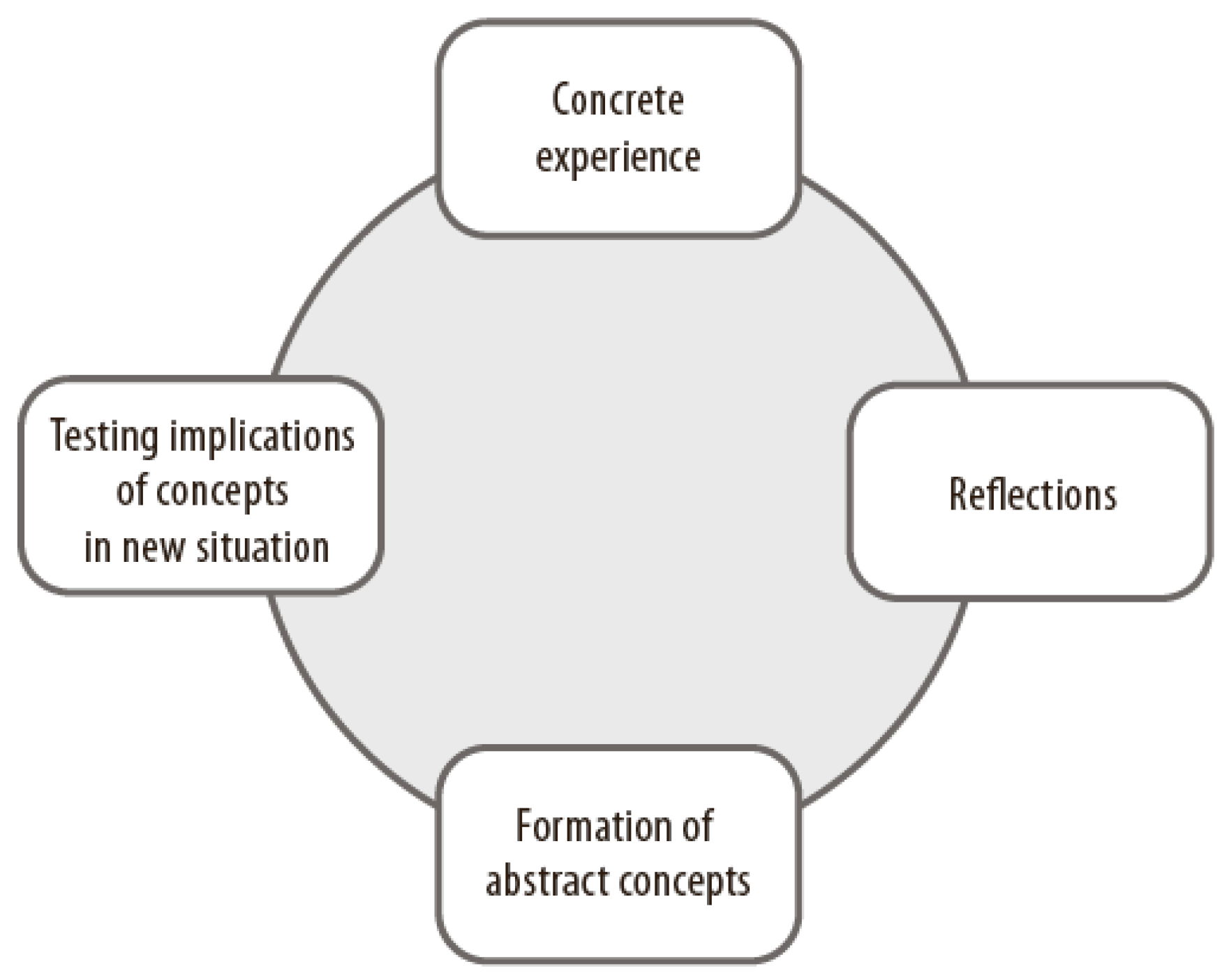
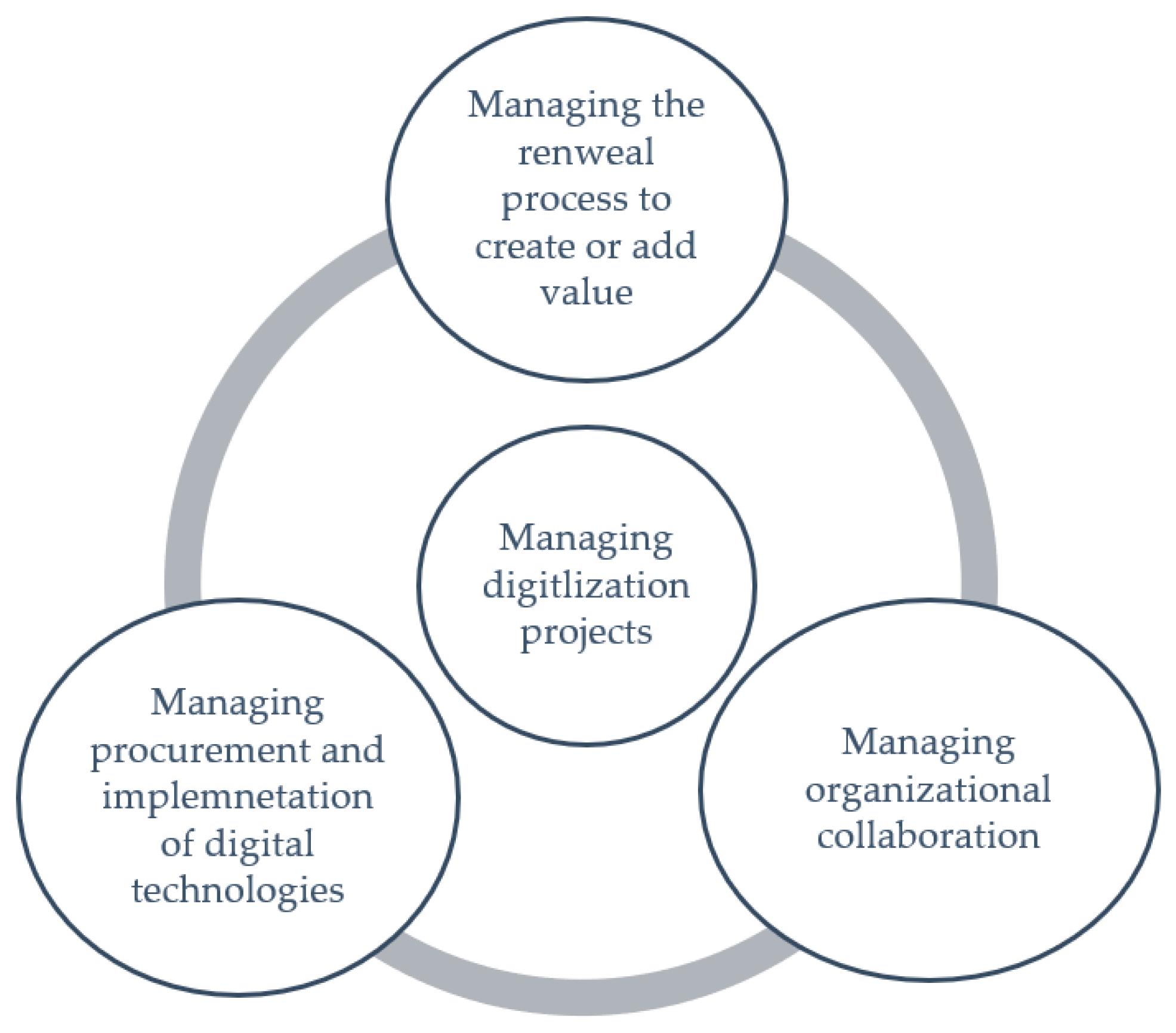

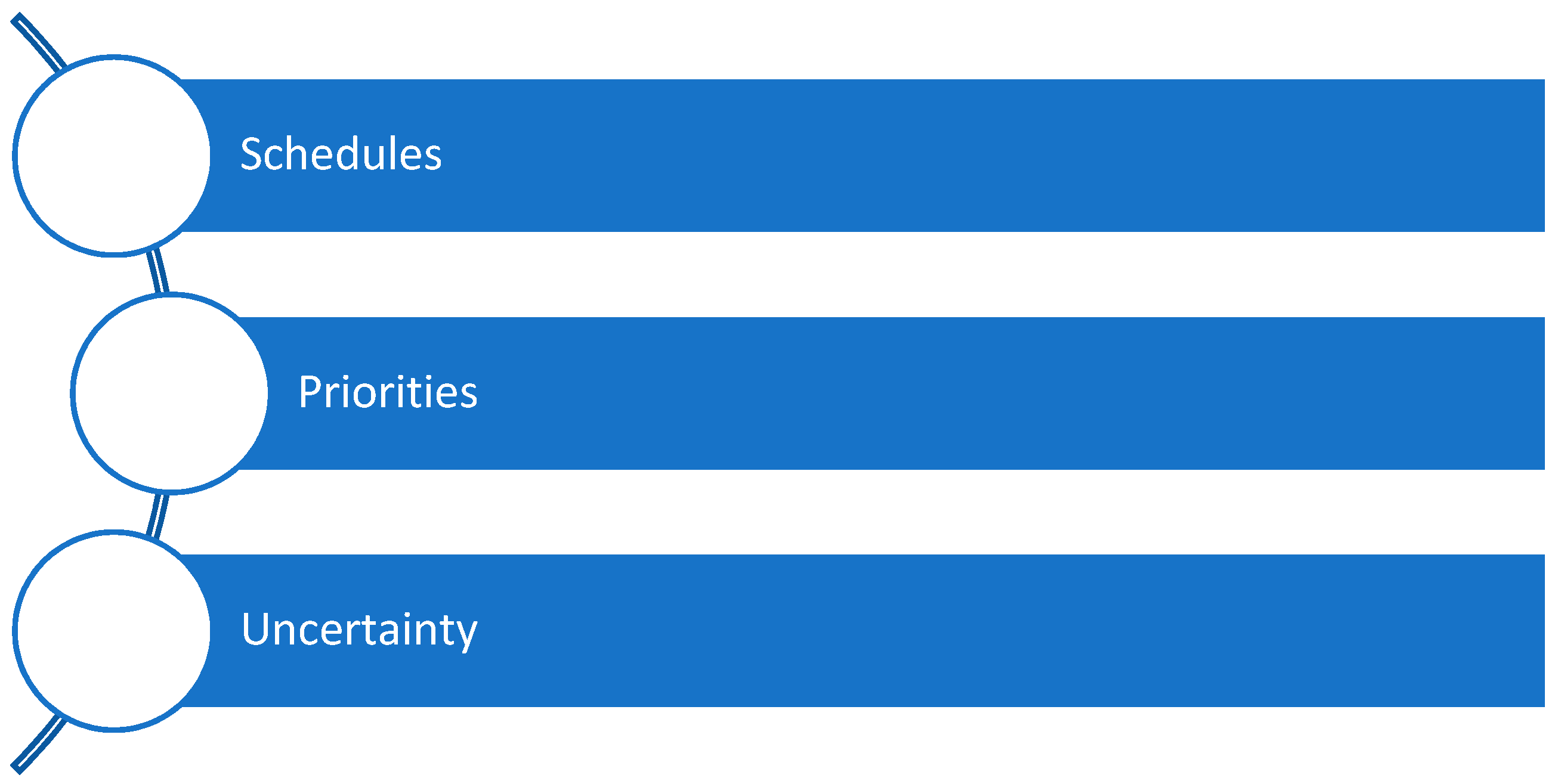
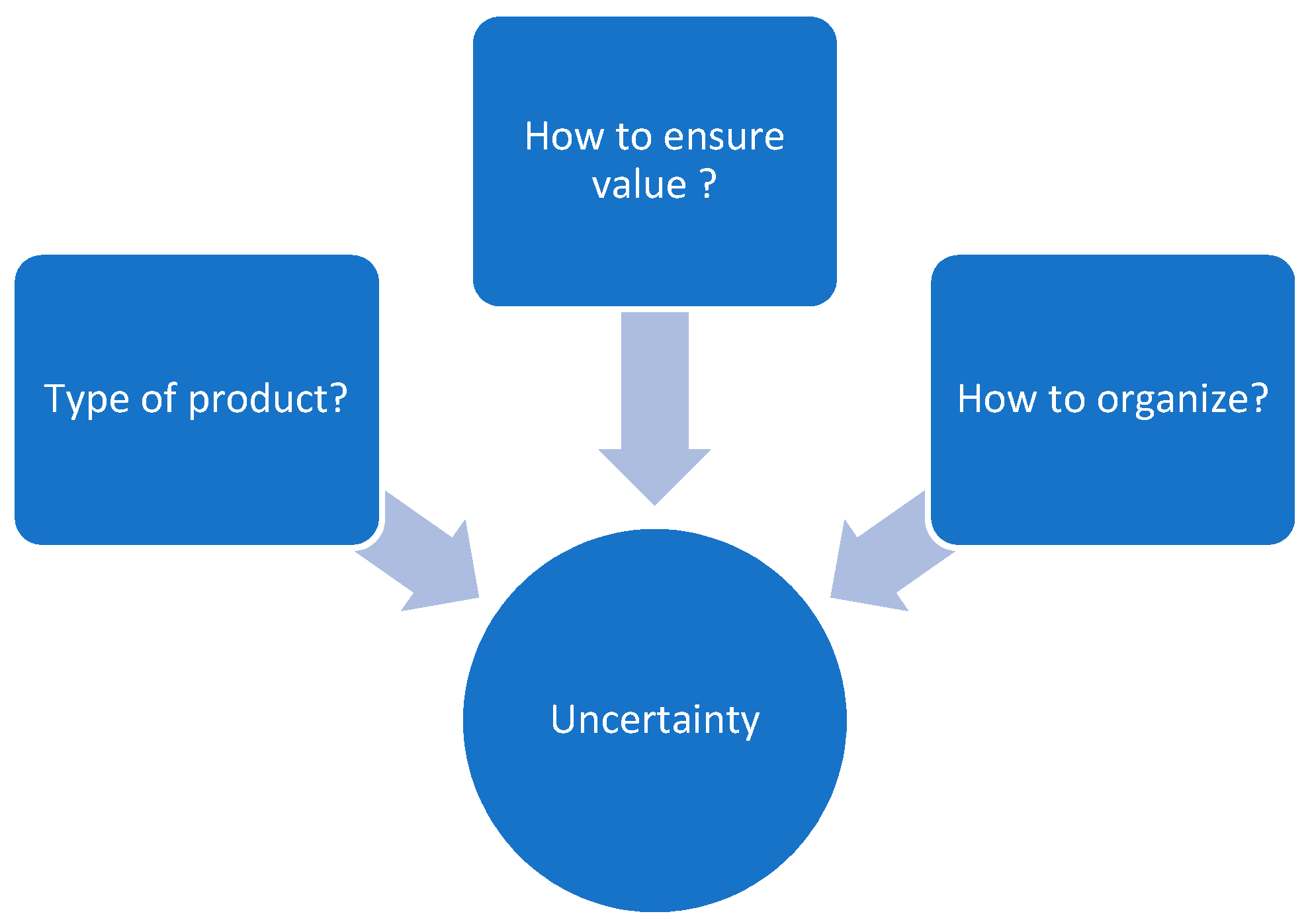
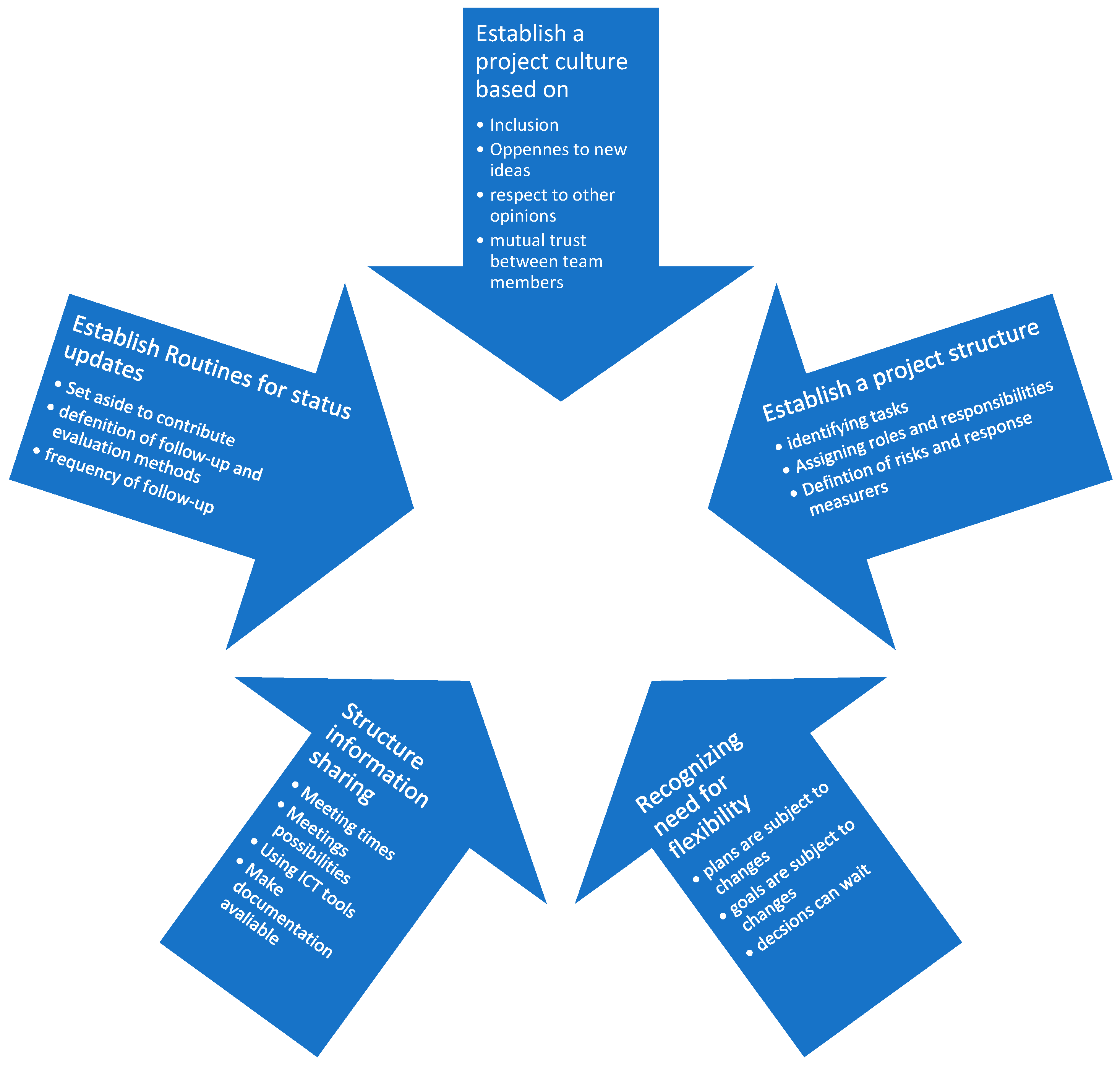
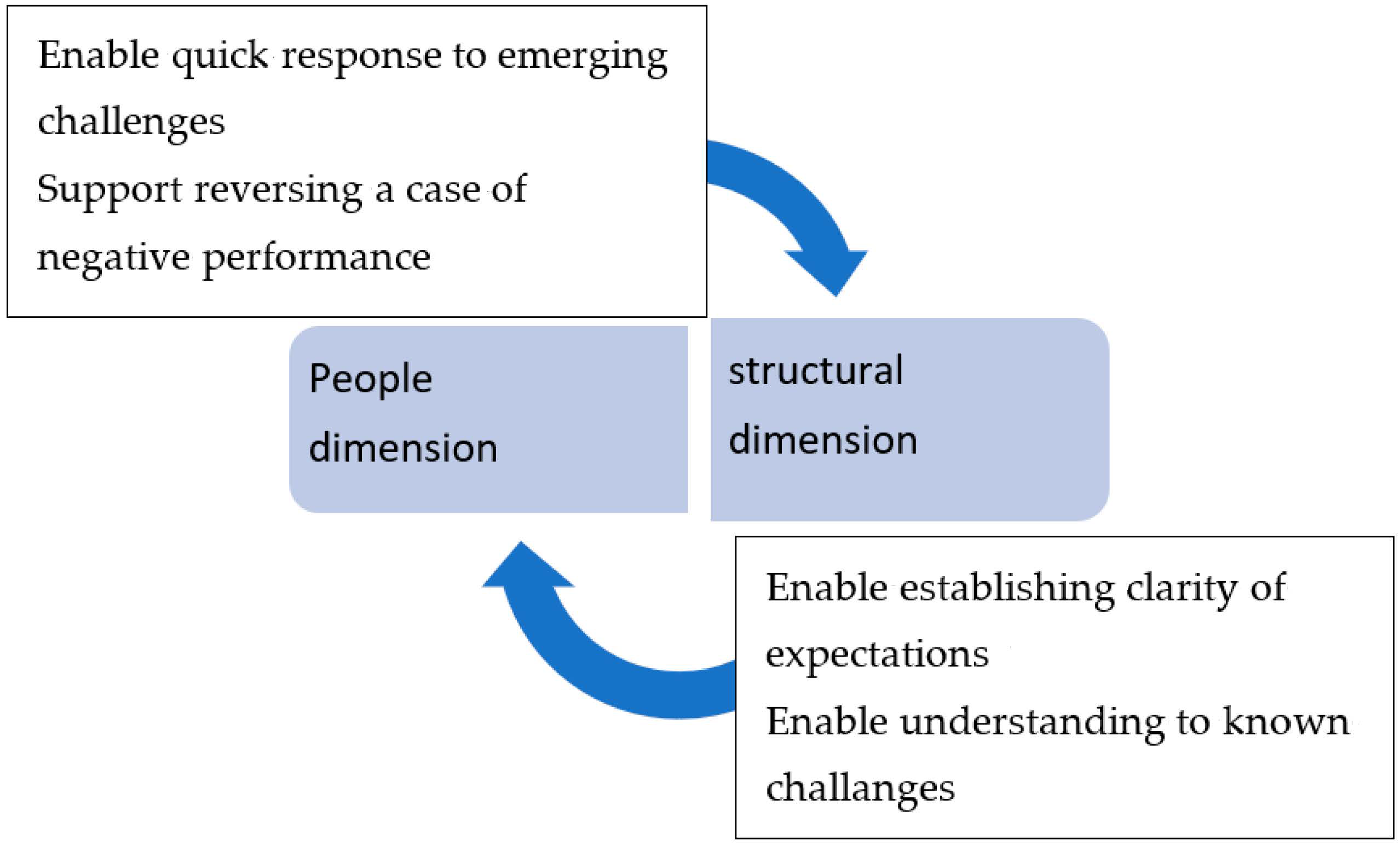
Publisher’s Note: MDPI stays neutral with regard to jurisdictional claims in published maps and institutional affiliations. |
© 2021 by the author. Licensee MDPI, Basel, Switzerland. This article is an open access article distributed under the terms and conditions of the Creative Commons Attribution (CC BY) license (https://creativecommons.org/licenses/by/4.0/).
Share and Cite
Hussein, B. Addressing Collaboration Challenges in Project-Based Learning: The Student’s Perspective. Educ. Sci. 2021, 11, 434. https://doi.org/10.3390/educsci11080434
Hussein B. Addressing Collaboration Challenges in Project-Based Learning: The Student’s Perspective. Education Sciences. 2021; 11(8):434. https://doi.org/10.3390/educsci11080434
Chicago/Turabian StyleHussein, Bassam. 2021. "Addressing Collaboration Challenges in Project-Based Learning: The Student’s Perspective" Education Sciences 11, no. 8: 434. https://doi.org/10.3390/educsci11080434
APA StyleHussein, B. (2021). Addressing Collaboration Challenges in Project-Based Learning: The Student’s Perspective. Education Sciences, 11(8), 434. https://doi.org/10.3390/educsci11080434





